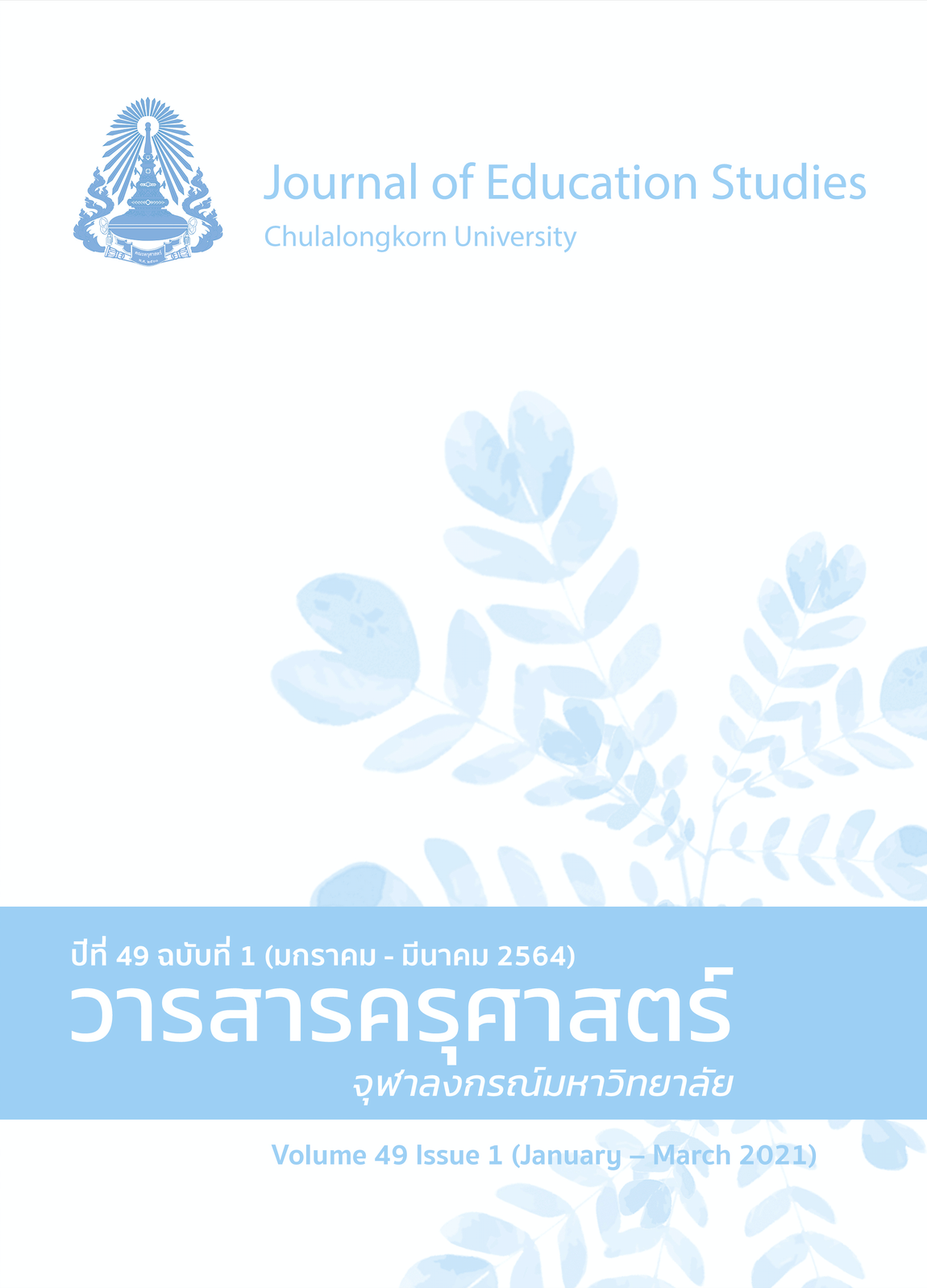รูปแบบการจัดการห้องสมุดดิจิทัลที่มีประสิทธิผลสำหรับโรงเรียนมัธยมศึกษาขนาดใหญ่พิเศษ
DOI:
https://doi.org/10.14456/educu.2021.11คำสำคัญ:
รูปแบบการจัดการห้องสมุดดิจิทัล, โรงเรียนมัธยมศึกษาขนาดใหญ่พิเศษบทคัดย่อ
งานวิจัยนี้มีวัตถุประสงค์เพื่อศึกษาสภาพ กำหนดรูปแบบการจัดการห้องสมุดดิจิทัลที่มีประสิทธิผลสำหรับโรงเรียนมัธยมศึกษาขนาดใหญ่พิเศษ ตัวอย่าง คือ ห้องสมุดดิจิทัล จำนวน 290 แห่ง ผู้ให้ข้อมูล ได้แก่ ผู้บริหาร หัวหน้าครูบรรณารักษ์ รวมทั้งสิ้น 580 คน เครื่องมือที่ใช้ ได้แก่ แบบสอบถามและแบบสัมภาษณ์เชิงลึก วิเคราะห์ข้อมูลโดยการหาค่าเฉลี่ย ส่วนเบี่ยงเบนมาตรฐาน วิเคราะห์องค์ประกอบด้วยวิธี principal-component analysis (PC) และวิธีหมุนแกนออโธกอนอลแบบวาริแมกซ์ (varimax orthogonal) ส่วนข้อมูลเชิงคุณภาพใช้การวิเคราะห์เนื้อหา ผลการวิจัย พบว่า สภาพการจัดการห้องสมุดดิจิทัลฯ ในภาพรวมมีประสิทธิผลในระดับมาก รูปแบบการจัดการห้องสมุดดิจิทัลฯ เป็นชุดของเนื้อหา วัตถุประสงค์ กระบวนการ วิธีการ และการประเมินผล โดยมีองค์ประกอบด้านการจัดการ ได้แก่ ด้านการวางแผน ด้านการปฏิบัติ ด้านการกำกับ และตรวจประเมิน รูปแบบการจัดการห้องสมุดดิจิทัลฯ ที่สร้างขึ้น ในภาพรวมมีความถูกต้อง ความเป็นไปได้ และความเป็นประโยชน์อยู่ในระดับมากที่สุด ขณะที่ข้อมูลมีการกระจายตัวน้อย
เอกสารอ้างอิง
กระทรวงศึกษาธิการ. (2557). แผนแม่บทเทคโนโลยีสารสนเทศและการสื่อสารเพื่อการศึกษา กระทรวงศึกษาธิการ พ.ศ. 2557-2559. สำนักงานปลัดกระทรวงศึกษาธิการ. http://www.ops.moe.go.th/ops2017/ผู้บริหารระดับสูง-สป/เกี่ยวกับ-cio/การบริหารงานด้าน-ict/แผนแม่บท
จันทรานี สงวนนาม. (2553). ทฤษฎีและแนวปฏิบัติในการบริหาร (พิมพ์ครั้งที่ 2). บุ๊คพอยท์.
ชินภัทร ภูมิรัตน์. (2555). โรงเรียนมาตรฐานสากล ผู้เรียนมีศักยภาพเป็นพลโลก. World Class School Thai. http://www.worldclassschoolthai.net
น้ำทิพย์ วิภาวิน. (2552). การรู้เรื่องการอ่าน การรู้สารสนเทศ และการรู้เท่าทันเทคโนโลยีสารสนเทศ Reading literacy, information literacy, and ICT literacy. บรรณศาสตร์ มศว., 2(1), 109-123. http://ejournals.swu.ac.th/index.php/jlis/article/view/3009
ปรียาพร วงศ์อนุตรโรจน์. (2553). การบริหารงานวิชาการ. พิมพ์ดี.
วิจารณ์ พานิช. (2555). วิถีสร้างการเรียนรู้เพื่อศิษย์ในศตวรรษที่ 21. มูลนิธิสดศรีสฤษดิ์วงศ์.
สำนักงานคณะกรรมการการศึกษาขั้นพื้นฐาน. (2557). แนวทางการจัดทักษะการเรียนรู้ในศตวรรษที่ 21 ที่เน้นสมรรถนะทางสาขาวิชาชีพ. สำนักบริหารงานการมัธยมศึกษาตอนปลาย.
สำนักงานคณะกรรมการการศึกษาขั้นพื้นฐาน. (2560). ห้องเรียนแห่งคุณภาพ (DLIT classroom). https://dlit.ac.th/site/classroom.php
ภาษาอังกฤษ
Bloom, B. S. (1956). Taxonomy of educational objectives book 1: Cognitive domain. Longman Group.
Cresswell, J. W. (2008). Research design: Qualitative, quantitative and mixed methods. Sage.
Davenport, T. H., Long, D. W., & Beers, M. C. (1998). Successful knowledge management project. Sloan Management Review. https://sloanreview.mit.edu/article/
successful-knowledge-management-projects/
Feldstein, M. (2008). Feature: Predictions for 2008. eLearning Magazine, 1(3).
Hasegawa, S., Kashihara, A., & Toyoda, J. (2002). An e-learning library on the web. IEEE Computer Society Digital Library. https://doi.ieeecomputersociety.org/
10.1109/CIE.2002.1186211
He, D., Mao, M., & Peng, Y. (2006, October). DiLight: A digital library based e-Learning environment for learning digital libraries. In E-learn: World conference on e-learning in corporate, government, healthcare, and higher education (pp. 2845-2852). Association for the Advancement of Computing in Education (AACE).
Khan, B. H. (2008). A framework of e-learning. Books to Read. http://bookstoread.com/framework
Marshall, B., Zhang, Y., Chen, H., Lally, A., Shen, R., Fox, E., & Cassel, L. N. (2003, May). Convergence of knowledge management and e-learning: The GetSmart experience. In 2003 Joint conference on digital libraries (pp. 135-146). IEEE.
Marzano, R. J. (2001). Designing a new taxonomy of educational objectives. Corwin.
Probst, G., Raub, S., & Romhardt, K. (2000). Managing knowledge: Building blocks for success. John Willey & Sons.
Sallis, E., & Jones, G. (2002). Knowledge management in education. London Kogan.
Seadel, M., & Greifeneder, E. (2007). Defining a digital library. Library Hi Tech, 25(2), 169-173.
Takeuchi, H., & Nonaka, I. (2000). Classic work: Theory of organizational knowledge creation. In B. Thuraisingham, M. T. Maybury, & D. Morey (Eds.), Knowledge management: Classic and contemporary works (pp. 139-182). The MIT Press.
Takeuchi, H., & Nonaka, I. (2004). Hitosubashi on knowledge management. Saik Wah.
Watanabe, T. (2003). Knowledge management architecture of integrated education support. International Conference for Computers in Education. http://www.icce2001.org/cd/pdf/ p10/JP113.pdf
ดาวน์โหลด
เผยแพร่แล้ว
รูปแบบการอ้างอิง
ฉบับ
ประเภทบทความ
สัญญาอนุญาต

อนุญาตภายใต้เงื่อนไข Creative Commons Attribution-NonCommercial-NoDerivatives 4.0 International License.




